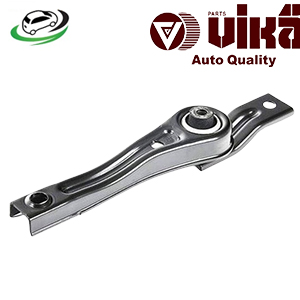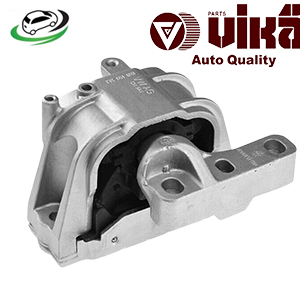-10%
Get Right Engine Mounting AUDI A3 (8P1)/ AUDI A3 Sportback (8PA)/ VW Beetle (5C1/5C2)/ Caddy III/ Caddy IV/ Golf Plus/ Golf V (1K1) 1K0199262L
The right engine mounting, also known as the right engine mount, is a vital component in a vehicle’s engine mounting system. It plays a crucial role in securing the engine to the vehicle’s chassis, absorbing vibrations, and minimizing engine movement. Understanding its function, design, common issues, and maintenance is essential for maintaining the vehicle’s performance and longevity.
Function of the Right Engine Mounting
The primary function of the right engine mounting is to secure the engine in place and provide stability while allowing for controlled movement. Here’s a breakdown of its key functions:
- Engine Support: The engine mount supports the engine’s weight and keeps it securely attached to the vehicle’s chassis. It prevents excessive movement of the engine during operation, which can lead to misalignment and damage.
- Vibration Dampening: Engine mounts absorb and dampen vibrations generated by the engine. Without effective vibration isolation, these vibrations can be transmitted to the vehicle’s cabin, leading to an uncomfortable ride and potential damage to other components.
- Engine Movement Control: While the engine mount provides support, it also allows for controlled movement of the engine. This controlled movement accommodates engine expansion and contraction due to temperature changes and helps absorb the impact of acceleration and braking forces.
- Noise Reduction: By isolating engine vibrations, the mount also reduces engine noise transmitted to the cabin. This contributes to a quieter and more pleasant driving experience.
Components of the Right Engine Mounting
The right engine mount typically consists of several key components that work together to achieve its functions:
- Mounting Bracket: The mounting bracket is attached to the engine and the vehicle’s chassis. It provides a rigid connection and ensures that the engine mount remains securely in place.
- Rubber or Elastomeric Pad: The rubber or elastomeric pad is the core of the engine mount. It absorbs vibrations and provides cushioning between the engine and the chassis. This material is designed to withstand engine heat, pressure, and movement.
- Metal Inserts or Plates: Metal inserts or plates within the rubber pad provide additional strength and support. They help distribute the engine’s weight and ensure that the mount remains structurally sound.
- Bolts and Fasteners: Bolts and fasteners are used to secure the engine mount to the engine and the vehicle’s chassis. Proper tightening and alignment of these components are essential for effective engine mounting.
Importance of the Right Engine Mounting
The right engine mounting is crucial for several reasons:
- Vehicle Stability: A properly functioning engine mount ensures that the engine remains securely attached to the chassis, maintaining vehicle stability and alignment. This prevents excessive engine movement that could affect handling and performance.
- Reduced Vibration and Noise: By absorbing engine vibrations and reducing noise, the engine mount enhances driving comfort and reduces cabin noise. This contributes to a more enjoyable driving experience.
- Preventing Damage: Effective engine mounting prevents excessive movement that could lead to damage to other engine components, the transmission, or the vehicle’s frame. It also helps prevent premature wear and tear on engine parts.
- Improved Performance: A stable engine contributes to smooth acceleration and braking, improving overall vehicle performance and responsiveness.
Common Issues with the Right Engine Mounting
Despite its robust design, the right engine mounting can experience several issues over time. Common problems include:
- Wear and Tear: The rubber or elastomeric pad can deteriorate due to exposure to engine heat, oil, and general wear and tear. This can lead to reduced effectiveness in vibration dampening and increased engine movement.
- Cracking or Fractures: Over time, the rubber pad can develop cracks or fractures, affecting its ability to support the engine effectively. This can lead to increased vibrations and noise.
- Loose or Worn Fasteners: Bolts and fasteners that secure the engine mount can become loose or worn. This can result in improper alignment and increased engine movement.
- Fluid Leakage: In some engine mounts, fluid-filled components are used for additional vibration dampening. Leakage of this fluid can reduce the mount’s effectiveness and lead to increased vibrations.
- Engine Movement: Excessive engine movement or noticeable engine shifting during acceleration or braking can indicate a problem with the engine mount. This can affect vehicle handling and performance.
Signs of a Failing Right Engine Mounting
Recognizing the signs of a failing right engine mount is crucial for timely intervention and repair. Common symptoms include:
- Increased Vibration: Excessive engine vibrations transmitted to the cabin can indicate a worn or damaged engine mount. This can result in a rough and uncomfortable ride.
- Engine Noise: Unusual engine noise, such as clunking or banging sounds, can be a sign of a failing engine mount. These noises may occur during acceleration, braking, or when shifting gears.
- Engine Movement: Visible engine movement or shifting, especially during acceleration or braking, can indicate that the engine mount is not providing adequate support.
- Rough Idling: A rough or unstable idle can be a symptom of a worn engine mount. The engine may shake or vibrate excessively while idling.
- Difficulty Shifting Gears: Difficulty in shifting gears or transmission-related issues can sometimes be linked to problems with the engine mount affecting alignment and stability.
Maintenance and Replacement of the Right Engine Mounting
Proper maintenance and timely replacement of the right engine mounting are essential for ensuring optimal vehicle performance and comfort. Here are some tips:
- Regular Inspection: During routine vehicle maintenance, inspect the engine mount for signs of wear, cracking, or damage. Check the condition of the rubber pad, metal components, and fasteners.
- Check for Leaks: If the engine mount is fluid-filled, check for signs of fluid leakage. Address any leaks promptly to prevent further damage and ensure proper functioning.
- Tighten Fasteners: Ensure that the bolts and fasteners securing the engine mount are properly tightened. Loose fasteners can affect engine stability and performance.
- Address Symptoms Promptly: If you notice any symptoms of a failing engine mount, such as increased vibration or unusual noises, have the mount inspected and replaced if necessary. Timely intervention can prevent further issues and ensure safe driving.
- Professional Assistance: If you are unsure about the condition of the engine mount or how to perform maintenance or replacement, consult a professional mechanic. They can diagnose the issue accurately and ensure proper repair or replacement.
Follow us on Facebook for more parts.



